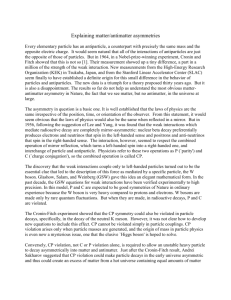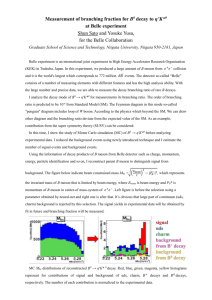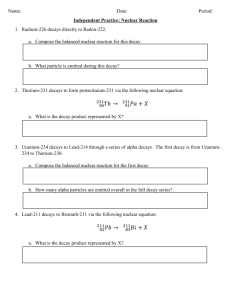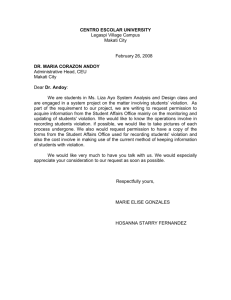B
advertisement
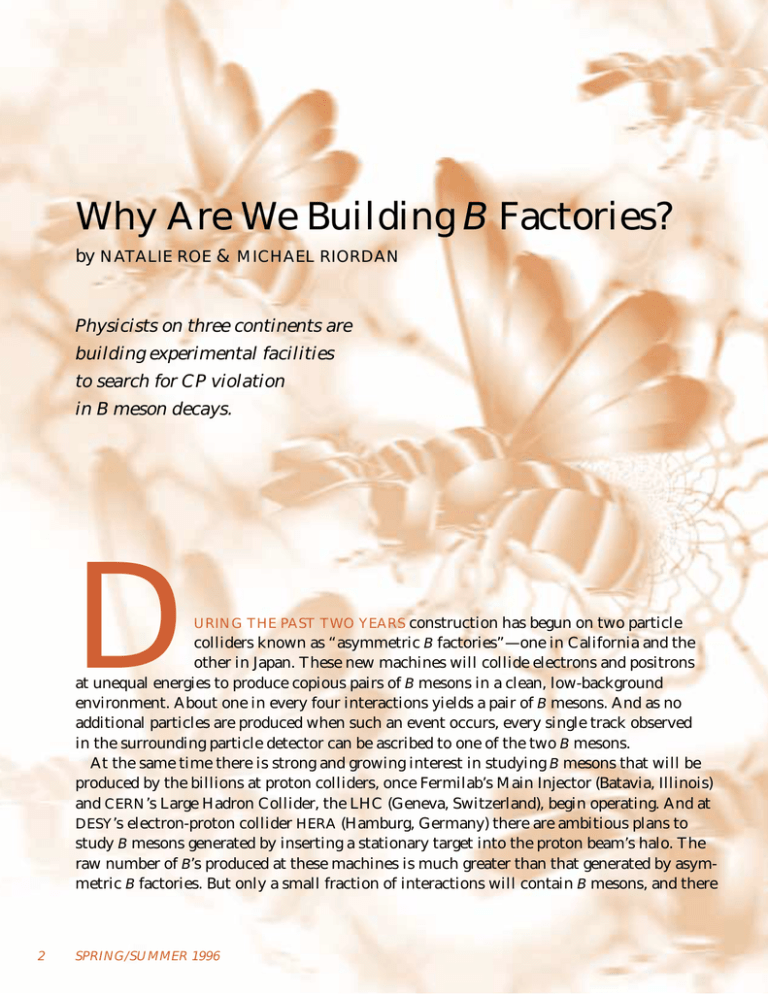
Why Are We Building B Factories? by NATALIE ROE & MICHAEL RIORDAN Physicists on three continents are building experimental facilities to search for CP violation in B meson decays. D URING THE PAST TWO YEARS construction has begun on two particle colliders known as “asymmetric B factories”—one in California and the other in Japan. These new machines will collide electrons and positrons at unequal energies to produce copious pairs of B mesons in a clean, low-background environment. About one in every four interactions yields a pair of B mesons. And as no additional particles are produced when such an event occurs, every single track observed in the surrounding particle detector can be ascribed to one of the two B mesons. At the same time there is strong and growing interest in studying B mesons that will be produced by the billions at proton colliders, once Fermilab’s Main Injector (Batavia, Illinois) and CERN’s Large Hadron Collider, the LHC (Geneva, Switzerland), begin operating. And at DESY’s electron-proton collider HERA (Hamburg, Germany) there are ambitious plans to study B mesons generated by inserting a stationary target into the proton beam’s halo. The raw number of B’s produced at these machines is much greater than that generated by asymmetric B factories. But only a small fraction of interactions will contain B mesons, and there 2 SPRING/SUMMER 1996 will be lots of extraneous tracks in every event. Extracting a clean signal in the face of such difficult conditions is a challenging but not impossible task—one that promises great rewards for dedicated experimenters. At the core of all the recent interest in B mesons is the prospect of encountering additional examples of CP violation. In 1963 Jim Cronin, Val Fitch, and their colleagues discovered this asymmetry between matter and antimatter in certain decays of neutral K mesons. But despite more than a quarter century of searching, no other instance of this intriguing phenomenon has ever been observed. It may be a natural consequence of the Standard Model of elementary particle physics, or perhaps our first glimpse of new physics beyond the Standard Model. Painstaking studies of K meson decays have yet to resolve this issue (see article by Jack Ritchie in the last issue of the Beam Line, Vol. 25, No. 4), in part due to the intrinsic theoretical uncertainties in these processes. Finding another example of CP violation—and measuring it in detail— is the crucial next step in understanding this phenomenon, which many cosmologists reckon to be the central element in explaining the matter-antimatter asymmetry of the Universe. B mesons promise to be an especially powerful tool in this search, having many decay modes in which the Standard Model predicts large particle-antiparticle asymmetries with little theoretical ambiguity. And there are other important reasons for studying B mesons, too. One of their constituents, the bottom, or b, quark is the second-heaviest quark in the Standard Model. The heaviest is the recently discovered top, or t, quark, whose observation by the CDF and DØ experiments at Fermilab put the capstone on the matter content of the Model. But the t quark is so top-heavy that it falls apart before it can form a bound state with other quarks; in a tiny fraction of an eyeblink, it disintegrates into a b quark and a W boson. By contrast, the much stabler b quark survies long enough to form bound states with other quarks, each exhibiting a rich variety of decay modes and offering opportunities to study the dynamics of heavy-quark interactions. This research is being pursued not only at Fermilab but also at Cornell, which operates a symmetric (equal electron and positron energies) B factory—as well as at the LEP and SLC colliders at CERN and Stanford Linear Accelerator Center (SLAC) respectively, where B’s produced in the decays of massive Z bosons have yielded a variety of interesting results. T HE b QUARK and B mesons were discovered in the late 1970s and early 1980s, during the consolidation of the Standard Model as the dominant particlephysics theory. Physicists were beginning to recognize that the elementary building blocks of matter come in families with two quarks and two leptons apiece. Thus the 1976 discovery by Martin Perl and his colleagues (see article by Perl in last issue of the Beam Line, Vol. 25, No. 4) of a third charged lepton, the tau lepton, suggested the existence of another pair of quarks. An initially obscure—but now famous—paper by two Japanese theorists, Makoto Kobayashi and Toshihide Maskawa, indicated CP violation could occur naturally in the Model if and only if a third such family existed. The discovery of the bottom quark was not long in coming. In 1977 a group of physicists led by Leon Lederman reported the discovery of the massive Upsilon particle in collisions of high-energy protons with nuclei at Fermilab. It was widely believed to be a neutral meson composed of a charge −1/3 quark plus its antiquark. Perhaps the b? In the early 1980s, the CLEO experiment at Cornell’s electron-positron collider CESR bore out this picture with the discovery of B mesons, composed of a b quark and a light quark, in decays of an excited state of the Upsilon, designated the (4S). The B meson lifetime was first measured at SLAC using the PEP collider, which ran at a higher energy than CESR. Although the rate of B meson production was much lower at PEP, the B’s came flying out with enough momentum to travel a measureable distance before they disintegrated—almost 1 mm, on the average. This was a big surprise, as it meant the B lifetime was much longer than expected. In 1986–87 the high energy physics community became very excited by another surprise: the obser– vation of “B0B 0 mixing,” in which a neutral B meson spontaneously converts into its antiparticle. This phenomenon was discovered by the UA1 experiment at CERN’s protonantiproton collider and confirmed by the ARGUS experiment at DESY’s electron-positron collider DORIS. Similar mixing behavior had been BEAM LINE 3 observed decades earlier for neutral K mesons, prior to the discovery of – CP violation. The high degree of B0B 0 mixing, when combined with the long B meson lifetime, soon suggested to physicists that CP violation might be observed in decays of neutral B mesons. Suddenly, B physics became a very hot topic. M OST OF THE DATA col- lected at electron-positron B factories is taken on the (4S) resonance. What makes this resonance so special is that, at a mass of 10.58 GeV, it has just enough energy to decay into two B mesons— and nothing else. This is an ideal experimental situation, because all the tracks in a given event can be assigned to one B meson or the other. Another advantage at this energy is that production accounts for onefourth of all interactions, and Bmeson decays are readily distinguished by their topology from events containing lighter quarks. Physicists have exploited these favorable experimental conditions at CESR and DORIS, producing many exciting discoveries. In a collegial competition, these two groups have tried to outdo each other in devising clever analysis techniques in order to be the first with groundbreaking results. DORIS has now ceased operation, but CESR has been upgraded to higher luminosity and continues to set records for machine performance. It is the world’s highest-luminosity electronpositron collider and will maintain such an enviable position at least through 1998. Physicists working there are reaping record numbers of B mesons, continually improving our understanding of their behavior. 4 SPRING/SUMMER 1996 But the study of CP violation in B meson decay will be extremely challenging at CESR because of a major, fundamental limitation. In order to extract CP-violating asymmetries from the data (see box on the right), it is crucial to know the order in which the two B’s decay. But B mesons at a symmetric (4S) machine like CESR are produced almost at rest, traveling only about 30 microns or so before decaying. Such a distance is much too short to be resolved using present detector technology—which therefore makes it impossible to establish the exact moment at which each meson expires. Without this crucial information, it is exceedingly difficult to observe CP violation at a (4S)-producing machine. CP violation appears when there is a difference between the decay – rates of B0’s and B0’s to the same final state. The Standard Model predicts that this phenomenon will occur for certain special states known as “CP eigenstates,” which are symmetric in their matter-antimatter content (see box). Having observed such a decay, however, the poor experimenter does not know whether it originated – from a B0 or a B 0. The solution to this conundrum is to observe the other B; if it decays to a final state that can be clearly identified as matter or antimatter, it can be used as a “tag.” An excess of either kind of tag accompanying a given CP eigenstate is evidence for CP violation. But we are not quite home yet; we still need the timing information mentioned above. This is the primary reason for building asymmetric B factories—to give the (4S) a boost in one direction. The B mesons that emerge from Observing CP Violation at an Asymmetric B Factory IN THE STANDARD MODEL CP violation should occur in certain rare B decays to final states with equal matter and antimatter content called “CP eigenstates.” CP is a quantum-mechanical operator that simultaneously changes particles into their antiparticles and reverses the parity of a system; a CP eigenstate is a system of particles that is left unchanged by the action of the CP operator. When a B 0 decays to π+π−, for example, it yields a CP eigenstate. The charge-conjugation operator C changes the π+ to a π − and the π − to a π +, while the parity operator P has no effect at all because the pion has no spin, and the pair is produced in a state with zero angular momentum; we end up just as we started. Another CP eigenstate is J/Ψ Ks, because both the J/Ψ and the Ks are self-conjugate particles: they are their own antiparticles. Certain B decays to “near-CP eigenstates” (such as B0 → ρ+ π − and B 0 → J/Ψ K* ), in which matter-antimatter symmetry occurs at the quark level, can also be used in studies of CP violation. If there were perfect symmetry be– tween matter and antimatter, B 0 and B 0 mesons would decay to a CP eigenstate at exactly the same rate. The observation of a difference between these two decay rates would be evidence of CP violation. But there is a catch-22. Be– cause both B 0 and B 0 mesons can decay to a CP eigenstate, it is impossible to know which of the two processes occurred merely by observing the outcome. Fortunately, b quarks are always produced in quark-antiquark pairs; thus by establishing the identity of the other B meson, often called the “tagging B,” we can deduce the identity of its partner. Although the tagging B can oscillate before decaying, no penalty is paid for this effect in measurements on the (4S); this is an advantage of resonant production. The disadvantage is that if we don’t observe the order in which the two B ’s decay, the CP asymmetry vanishes. π– π– µ+ Ks µ– B(CP) Decays π0 D0 (4S) e+ e– Collision Point K+ ∼250 µm π 10 Events π+ 100 1 100 – π+ 10 B(tag) Decays A typical “golden event” at an asymmetric B factory. The first B meson decays into a J/ψ (which immediately decays to µ+µ−) and a Ks, while the second B yields a clear tag. The above drawing illustrates a “golden event” at an asymmetric B factory. The typical separation between the two B meson decays is about 250 microns at PEP-II or KEKB ener– gies. There are four possible event categories: (i) a B 0 tag followed by the decay to a CP eigenstate; (ii) a B 0 tag followed by the decay to a CP eigenstate; (iii) the decay to a CP – eigenstate followed by a B 0 tag; (iv) the decay to a CP eigenstate followed by a B 0 tag. By combining events from categories (i) and (iv), and those from categories (ii) and (iii), and plotting these two resulting event classes versus the time interval (or, equivalently, the distance) between the two B decays, we obtain distributions such as those shown at right above. In both there is an obvious departure from pure exponential falloff, with the first distribution showing a slight excess of events over the second. The difference between these two distributions represents a clear indication of CP violation. If we add the two distributions, however, we blur out this difference, and an exponential falloff is all that we can observe. This illustrates why the order of the B decays is crucial information to obtain in making measurements at the (4S). 1 0 400 Microns 800 Distributions of two categories of simulated golden events versus the separation between their two B-decay points. An experimentally observed difference between these two distributions would be firm evidence for CP violation. The top plot has events from categories i and iv while the bottom plot contains events from categories ii and iii. Consult the text for definitions of the four categories. Another interesting feature of B meson decays is that there are three distinct CP-violating asymmetries that are in principle measureable. They are related to each other and can be expressed as three angles of a triangle (called the “unitarity triangle”; see article by David Hitlin and Sheldon Stone, Beam Line, Vol. 21, No. 4, Winter 1991). Given two asymmetry measurements, the third is uniquely determined within the Standard Model framework, and their sum cannot exceed 180 degrees. In addition, there are several decay modes which can be used to measure each asymmetry, providing a consistency check for each angle individually. Other studies of heavy-quark decays will provide additional constraints on the allowed values for each of these three asymmetries, as well as on the magnitude of the three sides of the triangle. The complete set of B-meson decay measurements will therefore give us a very stringent self-consistency test of the Standard Model. BEAM LINE 5 Typical magnets for the low-energy ring (above) and high-energy ring (below) in PEP-II. 6 SPRING/SUMMER 1996 it generally decay at measurably different points along that direction, allowing an accurate determination of which expired first. The idea for an asymmetric B factory was first proposed in 1987 by Pier Oddone of Lawrence Berkeley National Laboratory (LBNL) in California. Elegant in its simplicity, his concept nevertheless met initially with considerable skepticism because of its challenges for accelerator builders. In conventional symmetric colliders the electron and positron bunches occupy the same beam pipe—traveling in opposite directions and guided by the same sets of focusing magnets. An asymmetric B factory requires two separate beam pipes, each with its own magnet system guiding electron or positron beams on independent journeys around the ring. It must also have a complicated interaction region, with magnets that bring the two beams together briefly (so that they can collide) and then immediately separate them. Previous two-ring colliders (such as DORIS at DESY in Germany) had run into severe difficulties and never reached their design luminosities. But Oddone soon launched a feasibility study at LBNL to examine this problem, joining forces with SLAC physicists. Their bold conceptual design spawned a number of asymmetric B factory proposals all over the world, two of which are now under construction. KEK in Japan and SLAC are both recycling existing electron-positron colliders into asymmetric B factories. SLAC is upgrading the PEP collider into PEP-II, while KEK is transforming its TRISTAN collider into KEKB. Both colliders were originally designed to operate at much higher energies but with lower currents, and with equal-energy beams counterrotating inside a single beam pipe. In their new incarnations, they will be transformed into two-ring colliders, with completely new systems to power and control beams that have almost 100 times more circulating current. There is an important difference in approach, however. In KEKB the electron and positron beams collide at a slight angle, which allows the beams to be separated easily after they cross one another, while in PEP-II they collide head-on. Although there is a risk that the KEKB scheme could result in lower luminosity, as happened on DORIS, the advantage is that no bending magnets are needed close to the interaction region to separate the beams. This allows more room for particle detectors and reduces the backgrounds from synchrotron radiation. At PEP-II the beams are brought together and then separated by means of permanent bending magnets positioned a mere 20 cm from the interaction point. The large synchrotron radiation background generated by bending the beams is absorbed in a series of water-cooled masks located inside the beampipe. This rather conservative approach to accelerator design forces experimenters to be very creative in devising means to squeeze their detectors into the limited space remaining around the machine components. KEK and SLAC have also begun building ambitious new state-of-theart particle detectors to record the tracks and energy deposits left by decaying B mesons. The detector at KEKB is known as Belle, while the one at PEP-II is called BaBar—after the elephant in Laurent DeBrunhoff’s children’s stories. These two detectors are fairly similar in most aspects, differing only in certain technical details. At the heart of both detectors is a precision vertex detector that can determine the B-decay vertices to better than 100 microns. In BaBar the vertex detector is mounted directly on the final bending magnets. Based on silicon-strip detectors (see article by John Jaros and Alan Litke, Beam Line, Vol. 20, No. 1, Spring 1990), this precision tracking device is crucial for the measurement of CP-violating asymmetries and must be located as close as possible to the interaction point. In both Belle and BaBar, low-mass drift chambers will measure particle momenta while minimizing multiple scattering, and precision electromagnetic calorimetry based upon cesium-iodide crystals will determine photon energies. Pions, kaons and protons will be identified in new and different ways. In Belle a threshold Cherenkov counter made of an extremely light, diaphanous substance called aerogel (see photograph right) will be augmented by high-precision time-of-flight counters, while BaBar will use a novel device known as DIRC, for Detection of Internally Reflected Cherenkov light. An important feature of these detectors is their ability to record tens of millions of B-meson events per year. Massive computing power will be needed to sift through these enormous data samples offline to find the truly interesting events. “Factorylike” operation is required to produce such huge samples because experimenters expect to detect CP violation only in rare events that occur less than once in a thousand or so B decays. For example, the decay process B0→ J/Ψ Ks is a particularly obvious mode for observing this phenomenon because the J/Ψ occasionally breaks up into two easily identified muons. Such events comprise only about 0.05 percent of all B0 decays, however, and only a small fraction of them is easily reconstructed. Thus only 1 in every 40,000 B0 decays results in such an observable golden event. This yield is further depleted by the effects of imperfect detector acceptance and efficiency. And the tagging B must be accurately identified, resulting in a further 70 percent loss. The net result is that for every 10 million (4S) events produced at an asymmetric B factory and recorded by the detector, slightly more than 100 tagged golden events will be found that are useful in the search for CP violation. When operating at design luminosity, PEP-II and KEKB will record – about 30 million B 0B0 events per year, which should be sufficient to observe at least two of the three CP-violating asymmetries expected in the Standard Model (see box on pages 4 and 5). In the clean environment of the B KEK physicist peers through a sample of aerogel, to be used for the Cherenkov counter in the Belle detector. BEAM LINE 7 factory, we can reconstruct several different final states for each asymmetry measurement and combine them to enhance the statistical significance. If CP violation is observed as expected, these tests will tell us conclusively how the phenomenon originates. And if unexpected results occur, the capability of observing many different final states will be a powerful tool to scout for potential new physics. I N ADDITION to the Babar and Belle experiments at SLAC and KEK, there are proposals to search for CP violation in B decays using Fer- milab’s Tevatron collider and the HERA collider at DESY. Like the B factories, these experiments are scheduled to begin taking data in 1998 or 1999. There are also experiments being planned for CERN’s new LHC that have targeted CP violation; they promise to make measurements at much higher precision than the planned initial round of “discovery” experiments. Although these experiments will each confront different challenges, they have several features in common. Because B mesons are produced nonresonantly in hadron collisions, it is enough to observe that one B decays to J/Ψ Ks (for example) and to tag the other one, without measuring the timing of the two disintegrations. And at the higher energies of hadron colliders, B mesons travel visible distances before decaying—almost a full centimeter at HERA-B, for example— so lifetime information is readily available to help reject undesirable backgrounds and improve the experimental sensitivity. 8 SPRING/SUMMER 1996 The raw numbers of B’s produced will be orders of magnitude larger than at KEKB and PEP-II, but B events constitute only a small fraction of all events, and most ordinary B decays are difficult to distinguish from background processes. Selection of the most interesting B decays to be written onto tape must be done in a few microseconds using a sophisticated electronic triggering system. (In contrast, Belle and BaBar will be able to record essentially all B decays for later offline analysis.) Such an event trigger is required to recognize certain decays based on rapid reconstruction of important event characteristics. This feat is fairly easy with such an obvious final state as J/Ψ Ks, but it is more difficult for other states such as π+π −. Several experiments are developing powerful event triggers based on quick detection of a displaced vertex; if successful, they could open the door to the study of additional CP eigenstates beyond the J/Ψ Ks. A different sort of asymmetric collision will take place at DESY, whose electron-proton collider HERA will be adapted for a novel experiment called HERA-B. The plan is to collide HERA’s 820 GeV proton beam with stationary nuclei in a wire target inserted into the halo of the beam; that way the experiment can run without interefering with the normal HERA program. The rate of B-meson production in proton-nucleus collisions is not known to better than a factor of 2 at this energy, but a conservative estimate is several hundred million B’s per year. Only about one in a million interactions will actually contain B mesons, which will be embedded in an extremely high total data rate— vastly higher than a particle detector can hope to record. In addition, an average of three background events will be superimposed on every B event. Experimenters must therefore extract the B decay products from up to 200 tracks in order to reconstruct a golden event and tag the other B without being confused by all the other particles. To achieve this goal, the detector must be highly segmented to resolve so many particles, and radiation-resistant to survive the intense environment close to the beam line. These are daunting challenges, but physicists working on HERA-B have one very important thing in their favor—a working accelerator. They have already performed tests with an internal wire target and have successfully obtained the necessary interaction rate without seriously degrading the operation of HERA’s other experiments. As detector prototypes are constructed, they will be subjected to online testing in order to assess their performance and begin to get experience studying B’s in this unique environment. HERA-B is scheduled to have its first full-scale run in 1998, about a year before PEP-II and KEKB begin colliding beams. The main goal of HERA-B is to observe CP violation using B0 → J/Ψ Ks events, which are by far the easiest to identify in high backgrounds. Several hundred of these golden events are anticipated per year. Other final states, which could increase the statistical accuracy and provide important cross-checks, will be much harder to isolate. B while, physicists have already demonstrated that the Tevatron p–p collider is competitive in B physics. They have ambitious plans to search for CP violation after the Main Injector upgrade is completed in 1999, increasing the luminosity by a factor of 10. Once this is achieved, the Tevatron will become the most prolific B factory in the world, producing about one hundred billion B’s per year. At 2 TeV about one in a thousand p–p interactions contain B mesons, and these events typically contain extraneous tracks produced in the underlying collision. This situation is much more favorable than at HERA-B, although more challenging than the absolutely clean environment of an asymmetric electron-positron collider. Of the two experiments now running at the Tevatron, CDF is better optimized for B physics at present; the collaboration has published interesting measurements on B-meson lifetimes, mixing, production cross sections and masses. In addition, it has already reconstructed over 100 B0 → J/Ψ Ks events (see graph above) and over 600 B+ → J/Ψ K + events that can be used to evaluate tagging techniques. Both the CDF and DØ collaborations are planning extensive upgrades to improve their sensitivity to B-meson decays; they expect to be able to obtain several hundred tagged J/Ψ K s events per year. And CDF physicists are designing a sophisticated silicon vertex track processor that will allow them to trigger on displaced vertices. If successful, it would also give them access to other Events per 10 MeV ACK AT FERMILAB , mean60 40 20 0 5.20 5.25 5.30 Invariant Mass (GeV) 5.35 Preliminary CDF data on the production of J/Ψ Ks events, plotted versus the invariant mass of the J/Ψ Ks system. About 138 events are included under the peak. final states such as π+π −. In addition to seeking CP violation, both Tevatron experiments will continue to improve their lifetime and mixing measurements, search for rare Bdecay modes and examine the formation of expected but as-yetunobserved mesons and baryons. In many respects, the Tevatron program is complementary to those of the asymmetric B factories—offering greater breadth in B physics topics, although perhaps less depth in the variety of accessible CP-violating decay modes. first to observe CP violation in the golden-decay mode B0 → J/Ψ Ks will be intense, and should bring out the best in experimental effort and ingenuity. But there is much more to this Bphysics program than just a single asymmetry measurement. The Standard Model predicts a rich and complex pattern including three different CP-violating asymmetries—each potentially observable in a variety of B-decay modes. The measurements of different modes that probe the same asymmetry must agree with one another, and the three asymmetry angles must add up to 180 degrees, if the Standard Model is correct. An experimental program capable of measuring CP violation in a variety of different channels, including at least two of the three different asymmetries, will tightly constrain this theory and provide the ultimate precision test. And if Nature is kind, if there is still something truly exciting lying in wait, this broad physics program may provide enough clues to lead us into unexplored territory beyond the Standard Model. T HE PROJECTED time scales for completion of the asymmetric B factories at KEK and SLAC, the Main Injector upgrade of the Tevatron, and the HERA-B experiment are all roughly the same— with first results expected by the turn of the millenium. With so many physicists hot on its trail, CP violation will soon be examined more closely than ever before in its elusive thirty-year history. The race to be the BEAM LINE 9




